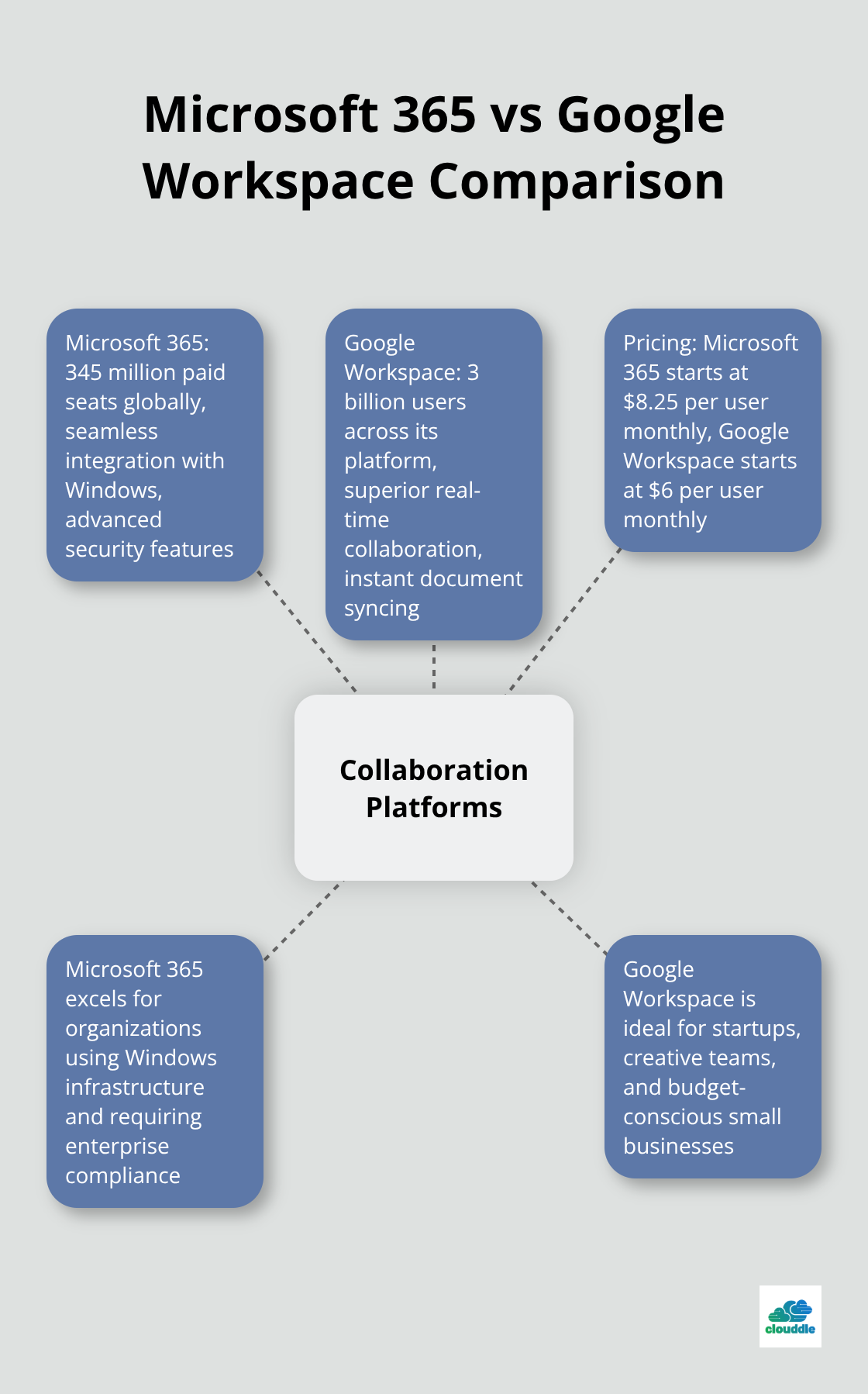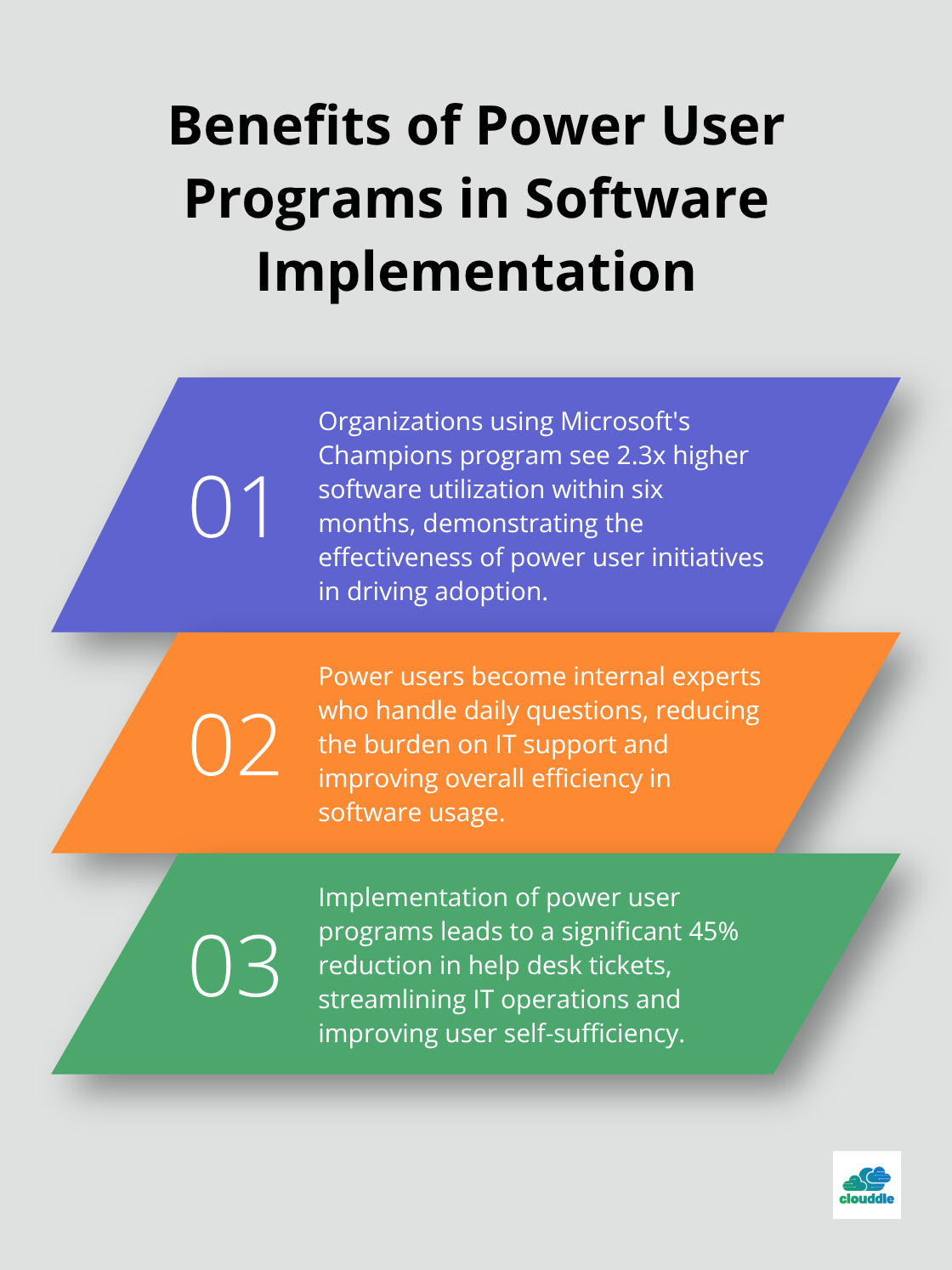Business efficiency depends on selecting the right IT software packages that streamline operations and boost productivity. Companies waste an average of 21.8 hours per week on inefficient processes, according to Smartsheet’s 2019 research.
At Clouddle, we’ve analyzed the most impactful software solutions across three core categories. This guide covers essential tools that can transform your business operations and drive measurable growth.
Which Software Categories Matter Most
Modern businesses require three fundamental software categories to operate efficiently. Productivity and collaboration tools form the backbone of daily operations, with mass emails with 20+ recipients up 7% in the past year while one-on-one threads decline by 5%. These platforms combine file sharing, video conferencing, and project management in unified environments. Companies that use integrated collaboration suites complete projects 25% faster compared to organizations that rely on standalone applications.
Customer Relationship Management Drives Revenue Growth
CRM systems generate the highest return on investment among business software categories. Salesforce research shows companies achieve $8.71 for every dollar they spend on CRM technology. HubSpot reports that businesses with comprehensive CRM platforms see 41% higher revenue per salesperson annually. These systems automate lead scoring, track customer interactions across channels, and provide sales forecasting accuracy above 85%.

Financial Management Software Completes the Essential Foundation
Financial management software completes the essential trio by automating accounting processes and reducing manual data entry errors by 67% (according to QuickBooks studies). Cloud-based accounting platforms like Xero process invoices 5x faster than traditional desktop solutions while they provide real-time financial reporting that supports strategic decision-making. Organizations that implement all three software categories create a technology foundation that supports scalable growth and operational excellence.
The next step involves examining specific software packages within each category to identify the solutions that deliver the greatest impact for your business operations.
Which Software Packages Deliver the Best Results
Microsoft 365 dominates the collaboration space with 345 million paid seats globally, while Google Workspace serves 3 billion users across its platform. Microsoft 365 wins for organizations that already use Windows infrastructure, as it offers seamless integration with existing systems and advanced security features that meet enterprise compliance requirements. Google Workspace excels for startups and creative teams with superior real-time collaboration capabilities – documents sync instantly across devices and multiple users can edit simultaneously without version conflicts.
The price difference matters significantly. Google Workspace starts at $6 per user monthly compared to Microsoft 365’s $8.25 entry point, which makes Google the clear choice for budget-conscious small businesses.
CRM Systems That Actually Generate Revenue
Salesforce captures 19.5% of the global CRM market but costs significantly more than alternatives, with plans that start at $25 per user monthly. HubSpot offers superior value for companies with its robust free tier that includes contact management for up to 1 million contacts and basic email marketing tools. Companies that use HubSpot’s marketing automation features see improved lead generation results.
Salesforce makes sense for enterprises that require complex customization and advanced reporting capabilities. HubSpot wins for small to medium businesses that seek immediate implementation and user-friendly interfaces without extensive technical setup requirements.
Financial Software That Eliminates Manual Work
QuickBooks processes over 4.2 million payroll transactions monthly and integrates with more than 750 third-party applications, which makes it the standard for established businesses with complex accounting needs. Xero targets companies with superior bank reconciliation features that automatically match transactions and reduce manual data entry by 82%.
Xero’s unlimited users policy contrasts sharply with QuickBooks’ per-user pricing model. Companies with multiple bookkeepers save hundreds monthly when they choose Xero over QuickBooks. Both platforms offer mobile apps, but Xero’s interface feels more intuitive for users without accounting backgrounds.
These software selections form the foundation of efficient business operations, but successful implementation requires careful planning and strategic deployment to maximize their impact on your organization. For comprehensive guidance on selecting the right solutions, consider exploring IT service packages that align with your specific business requirements.
How Do You Deploy Software Without Disrupting Operations
Most software implementation failures come not from developing poor models but from poor productization practices, according to McKinsey research. Start with a comprehensive workflow audit that maps every process your team currently uses. Document which applications handle each task, how data flows between departments, and where bottlenecks occur. This assessment reveals integration requirements and identifies processes that need immediate attention versus those that can wait.
Map Your Integration Points Before You Purchase
Integration complexity determines implementation success more than software features. Salesforce connects with over 5,000 applications through its AppExchange marketplace, while HubSpot offers 1,000+ integrations that sync customer data automatically. Test data migration between your current systems and new software during trial periods. QuickBooks users who migrate to Xero report average data transfer times of 48 hours for complete financial histories, but custom fields and complex reporting structures require manual reconstruction.
Train Power Users First Then Scale Training
Power user programs should deliver tangible business results through reduced operating costs from efficiency improvements. Microsoft reports that organizations using their Champions program see 2.3x higher software utilization within six months. Power users become internal experts who handle daily questions and reduce help desk tickets by 45%. Schedule intensive two-day training sessions for these champions, then deploy one-hour overview sessions for remaining staff.

Address Technical Infrastructure Requirements
Network capacity affects software performance more than most businesses anticipate. Cloud-based applications require consistent bandwidth (minimum 25 Mbps per 10 users for video conferencing platforms). Test your current infrastructure during peak usage hours before you commit to new software purchases. Microsoft 365 performs poorly on networks with latency above 150ms, while Google Workspace tolerates higher latency but requires stable connections for real-time collaboration features. Consider phased migration approaches to minimize business disruption during infrastructure upgrades.
Final Thoughts
The three essential IT software packages categories we examined form the foundation of modern business efficiency. Productivity and collaboration tools eliminate communication barriers, CRM systems drive revenue growth with measurable ROI, and financial management software automates critical accounting processes. Organizations that implement all three categories create integrated workflows that support scalable operations.
Implementation success depends on thorough workflow assessment, strategic integration plans, and comprehensive training programs. Power user champions accelerate adoption rates while proper infrastructure preparation prevents performance issues. Companies that follow these deployment strategies see higher utilization rates and faster return on investment.
Your next step involves selecting specific IT software packages that align with your business requirements and technical infrastructure (consider factors like user count, integration needs, and budget constraints). We at Clouddle help businesses implement comprehensive technology solutions that combine networking, security, and managed services for seamless operations. Consider partnering with technology solution providers who offer managed IT services and networking expertise to support your software deployment.


